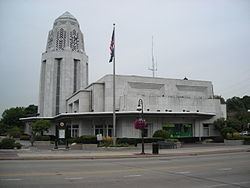Built 1940 Opened 1940 Added to NRHP 21 February 1991 | NRHP Reference # 91000087 Architectural style Streamline Moderne Architect R. Harold Zook | |
 | ||
Similar Tift County Courthouse, Bulloch County Courthouse, St Charles History Museum, Hotel Baker, Stimson House | ||
The St. Charles Municipal Building is a Registered Historic Place located on the east bank of the Fox River in St. Charles, Illinois.
Contents
History
The St. Charles Municipal Building was designed in 1940 by noted local architect R. Harold Zook, best known for designing the art deco Pickwick Theater in Park Ridge. Art deco was an inspiration for the St. Charles building, but the end result conformed more closely to the Moderne movement. The building was constructed on the former site of the Fixture Factory, which was destroyed in a 1929 fire. Col. Edward J. Baker and Mr. and Mrs. Lester J. Norris were the primary donors for the building; Baker and his niece Mrs. Norris were the heirs of the John W. Gates barbed wire and oil fortune. Baker funded many public works projects in St. Charles, including the Hotel Baker, Henry Rockwell Baker Memorial Community Center, St. Charles National Bank, and Baker Memorial United Methodist Church, and the Norrises also funded the Arcada Theater and Del-Nor Hospital. Baker was very interested in local history, and was adamant that the building have a wing dedicated to industrial history. The St. Charles Municipal Building was the first permanent building to exclusively use Fluorescent tube lighting, thanks to the efforts of R. A. Warren, the head of St. Charles Technical Laboratories. The building was dedicated on September 2, 1940. The original floor plan divided the structure into several city functions. The main entrance led to a general office with a waiting room for a bus stop and the city clerk's office on the south end. The west end featured cashier's offices, and a lobby leading to the rotunda. North of the main office area was an office for the superintendent of public works and a police office. The rotunda led to the industrial museum. A staircase accessed just east of the tower led to the second floor, which was mainly the city council chamber. A storage room was also built into the south end, and the mayor and city committee had offices on the north end. The St. Charles Municipal Building was recognized by the U. S. Department of the Interior as a Historic Place on February 21, 1991. In 1998, a mural was painted on the side depicting the history of St. Charles.
Architecture
The St. Charles Municipal Building was built on the east bank of the Fox River on the north side of Illinois Route 64. Art Deco and Moderne buildings such as the St. Charles Municipal Building were designed with "simple cubic forms and flat surfaces" which were emphasized for their modernity. Art Deco (1925-1933) ornament has pronounced verticality and is mechanistic and linear in quality. Favored motifs are faceted surfaces, zigzags, chevron patterns, and octagon shapes. The Municipal Building has all these elements. The typical Moderne public building is low and chunky in proportions with a tall element carefully balanced by lower sections. Ornament is spare and abstract. The St. Charles Municipal Building is truly a Moderne building which promotes this striking style through its maintained high degree of architectural integrity. The distinction of being classified as Moderne instead of Art Deco lies in the fact that the Municipal Building is an example of the phase of design after 1930 in which buildings were drastically stripped of surface ornaments and windows were grouped in bands.
White Georgia Marble with a black granite base provides an exterior appearance for the Municipal Building which, in its geometric forms, shows a conscious modernity and artistic expression to compliment the machine age. The centerpiece of the building is an 84 foot (26 m) tower. To support the structure, a limestone wall (cut from Indiana limestone) was built along the banks of the Fox River; the terrace on top of this structure features two fountains and a railing along the edge. Industrialization was emphasized in the building's program to provide an "Industrial Museum" in the north wing of the building (44 by 58 feet (13 m × 18 m)) with a 16 foot (4.9 m) high ceiling (the museum has since moved to the historic McCornack Oil Company at 215 East Main Street). The rest of the structure (66 by 96 feet (20 m × 29 m)) is two stories, with a 10 foot (3.0 m) ceiling on the first floor and a varying height ceiling on the second. The tower is a true octagon with a diameter of 31 feet (9.4 m). Stained glass windows feature on all sides of the rotunda, which is surrounded by an 8 foot (2.4 m) canopy on the west that extends to the south side of the building. The interior has been maintained since its original floor plan.
